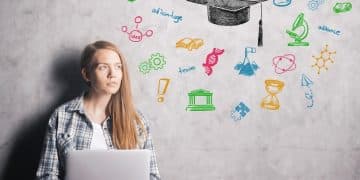Practical Solutions: Overcoming Learning Challenges & Achieving Goals

Advertisements
Practical solutions for overcoming learning challenges involve a multifaceted approach, blending personalized strategies, effective resource utilization, and a supportive environment to foster academic success and achieve educational aspirations.
Navigating the complex landscape of education often presents unforeseen hurdles, from grasping intricate concepts to managing time effectively. This article delves into Practical Solutions: Overcoming Learning Challenges and Achieving Your Educational Goals, offering actionable strategies to transform obstacles into opportunities for growth and academic triumph.
Understanding the Diverse Landscape of Learning Challenges
Learning is an inherently individual journey, yet it is rarely without its specific challenges. These obstacles can manifest in myriad forms, ranging from cognitive difficulties to environmental factors, each requiring a tailored approach for effective resolution. Recognizing the root cause of a learning challenge is the foundational step towards finding a practical solution.
Many students encounter difficulties with foundational subjects like mathematics or reading comprehension, which can be attributed to gaps in early education or distinct learning styles that are not adequately addressed by conventional teaching methods. Others face challenges related to executive functions, such as organization, time management, and focus, impacting their ability to complete assignments or prepare for exams efficiently.
Cognitive Processing Differences
Cognitive processing differences, such as dyslexia or ADHD, represent significant learning hurdles. These are not indicators of intelligence but rather different ways the brain processes information. Identifying these differences early can lead to effective accommodations and strategies. Some common challenges include:
- Information Retention: Difficulty remembering facts, formulas, or historical dates.
- Reading Speed and Comprehension: Struggling to read fluently or grasp the main ideas of texts.
- Mathematical Reasoning: Challenges with abstract mathematical concepts or problem-solving.
- Attention and Focus: Difficulty sustaining attention in lectures or during independent study.
Understanding that these are not personal failings but rather aspects of neurological diversity is crucial. Educational systems are increasingly recognizing the need for differentiated instruction to support students with these varied processing styles, paving the way for more inclusive and effective learning environments.
Environmental and Socioeconomic Factors
Beyond individual cognitive profiles, external factors play a substantial role in learning challenges. A disruptive home environment, lack of access to educational resources, or socioeconomic disadvantages can create significant barriers to academic success. These factors often compound cognitive difficulties, making the learning journey even more arduous.
The digital divide, where some students lack reliable internet access or necessary devices, emerged as a prominent challenge. This disparity can sever connections to online learning platforms, research materials, and collaborative tools that are now integral to modern education. Addressing these systemic issues requires broader community and institutional support.
Ultimately, a comprehensive understanding of learning challenges extends beyond the classroom and into the student’s entire lived experience. It necessitates a holistic perspective that acknowledges the interplay of internal and external factors, guiding the development of truly practical and empathetic solutions.
Personalized Learning Strategies: Tailoring Education to the Individual
The concept of “one size fits all” simply does not apply to education. Effective learning strategies are those that are meticulously tailored to an individual’s unique needs, strengths, and preferred learning styles. This personalized approach moves beyond traditional methods, recognizing that each student has a distinct path to knowledge assimilation and application.
Developing personalized learning strategies begins with a thorough assessment of the student’s current abilities, past academic performance, and aspirations. This assessment informs the creation of an individualized learning plan that addresses specific challenges while leveraging inherent talents. It focuses on how an individual learns best, rather than just what they learn.
Identifying Learning Styles
Understanding one’s dominant learning style—visual, auditory, kinesthetic, or reading/writing—is a pivotal step. Once identified, educational content and study methods can be adapted to align with these preferences, significantly enhancing comprehension and retention. For instance, a visual learner might benefit from diagrams and mind maps.
Auditory learners, on the other hand, often thrive with lectures, discussions, or by listening to recordings of materials. Kinesthetic learners benefit most from hands-on activities, experiments, and movement during study breaks. A personalized strategy will often combine elements from multiple styles, leveraging the strongest ones while supporting weaker areas.
Moreover, personalized learning extends to setting realistic and achievable goals, breaking down complex tasks into manageable steps, and celebrating small victories along the way. This fosters a sense of accomplishment and maintains motivation, crucial for sustained effort in overcoming challenges.
Adaptive Technologies and Tools
The advent of adaptive technologies has revolutionized personalized learning. Software programs and applications that adjust to a student’s pace and provide immediate feedback are invaluable. These tools can identify areas where a student struggles and offer targeted exercises, creating a truly dynamic learning experience.

From gamified learning platforms to intelligent tutoring systems, modern technology offers a plethora of options for customized education. These resources can provide additional practice, alternative explanations, and a safe space for experimentation, allowing students to learn at their own speed without the pressure of a traditional classroom setting.
Furthermore, personalized learning strategies often incorporate self-reflection, encouraging students to evaluate their own progress, identify what works best for them, and adjust their approaches as needed. This meta-cognitive skill is not only vital for academic success but also for lifelong learning and personal development.
Effective Resource Utilization: Maximizing Available Tools
In today’s information-rich world, the sheer volume of educational resources can be overwhelming. The key to overcoming learning challenges lies not just in having access to resources, but in effectively utilizing them. This involves discerning high-quality, relevant materials from the noise, and integrating them strategically into one’s study routine.
Effective resource utilization also encompasses leveraging human capital, such as teachers, mentors, and peers. These individuals offer invaluable insights, alternative perspectives, and tailored guidance that no digital resource can fully replicate. Building a network of support is as important as finding the right textbooks.
Leveraging Digital Learning Platforms
Digital learning platforms, from MOOCs (Massive Open Online Courses) to dedicated educational apps, offer unparalleled access to diverse subjects and teaching methodologies. Platforms like Coursera, edX, Khan Academy, and specialized language apps provide structured courses, interactive exercises, and peer forums that can supplement traditional schooling.
- Online Tutorials and Videos: Visual and auditory learners can benefit immensely from platforms like YouTube, which hosts countless educational channels explaining complex topics in simplified formats.
- E-books and Digital Libraries: Access to a vast collection of academic texts and research papers, often free or at a reduced cost, expanding the breadth of available knowledge.
- Interactive Simulations: Especially useful for subjects like science and engineering, these tools allow for hands-on experimentation without physical constraints.
The strategic selection of these platforms, focusing on those that align with individual learning styles and specific learning goals, is crucial. It’s not about using every available platform, but rather selecting those that offer the most targeted and effective support.
The Power of Tutoring and Study Groups
While digital resources are plentiful, the human element in learning remains irreplaceable. One-on-one tutoring offers personalized instruction, immediate feedback, and the opportunity to clarify doubts in a supportive environment. Tutors can adapt their teaching methods in real-time, addressing specific areas of weakness more effectively than a generalized curriculum.
Study groups provide a collaborative learning environment where students can explain concepts to each other, stimulating deeper understanding and retention. Discussing material with peers can also reveal different perspectives and problem-solving approaches, enriching the learning experience. The act of teaching others is a powerful way to solidify one’s own understanding.
Moreover, active participation in these human-centric resources can foster a sense of community and accountability, which are vital for maintaining motivation and persistence when facing prolonged learning challenges. The combination of digital tools and human interaction creates a robust and versatile educational ecosystem.
Building Resilience and Mindset: Overcoming Mental Roadblocks
Learning challenges are not solely about academic content; they often involve significant mental and emotional components. The ability to persevere through difficulties, maintain a positive outlook, and bounce back from setbacks—a quality known as resilience—is paramount. Building a resilient mindset is as critical as acquiring knowledge.
Mindset, particularly a growth mindset, plays a pivotal role. A growth mindset teaches that abilities and intelligence can be developed through dedication and hard work, rather than being fixed traits. This perspective transforms mistakes into valuable learning opportunities and failures into temporary setbacks, fostering a proactive approach to challenges.
Cultivating a Growth Mindset
The concept of a growth mindset, popularized by Carol Dweck, encourages individuals to view challenges not as insurmountable barriers but as opportunities for development. This contrasts with a fixed mindset, where one believes their abilities are static. Practical steps include:
- Embracing Challenges: Viewing difficult tasks as chances to grow and learn, rather than as threats to one’s intelligence.
- Learning from Criticism: Seeing feedback as constructive information to improve, not as personal attacks or signs of inadequacy.
- Persisting in the Face of Setbacks: Understanding that effort and persistence are key to mastering new skills, even when progress is slow.
- Celebrating Effort: Recognizing and rewarding the process of learning and the dedication applied, not just the eventual outcome.
Shifting to a growth mindset can significantly reduce anxiety related to learning and performance, making the educational journey more enjoyable and sustainable. It empowers students to take ownership of their learning process and embrace the journey of continuous improvement.
Stress Management and Well-being
Chronic stress and poor well-being can severely hamper learning capacity and motivation. Practical solutions include incorporating stress-reduction techniques into daily routines. These can range from mindfulness and meditation to regular physical activity and ensuring adequate sleep.

Time management strategies can also reduce stress by creating a sense of control over academic demands. Techniques such as the Pomodoro Technique or creating detailed study schedules can help break down large tasks, making them less daunting. Prioritizing self-care is not a luxury but a necessity for sustained academic performance.
Moreover, seeking support from mental health professionals or school counselors when feeling overwhelmed is a sign of strength, not weakness. These resources can provide coping mechanisms and strategies to manage academic pressure, ensuring that mental roadblocks do not derail educational goals permanently.
Strategic Planning and Time Management: Mastering Academic Demands
One of the most common learning challenges, particularly in higher education, is managing the sheer volume of academic demands. Effective strategic planning and meticulous time management are not just organizational skills; they are critical components for retaining information, completing assignments on time, and reducing overall academic stress.
Without a clear plan, students can easily feel overwhelmed, leading to procrastination, missed deadlines, and a superficial understanding of concepts. Strategic planning involves setting clear, achievable academic goals and then mapping out the steps required to meet them. Time management is the disciplined execution of that plan.
Setting SMART Goals for Academic Success
The SMART goal framework (Specific, Measurable, Achievable, Relevant, Time-bound) is an excellent tool for academic planning. Instead of vague aspirations like “I want to do well,” SMART goals provide a clear roadmap and measurable outcomes:
For example, a vague goal like “Study for my exams” becomes a SMART goal: “I will study chapters 1-5 of my history textbook for one hour every evening from Monday to Friday this week to prepare for my mid-term exam on October 20th, aiming for a score of 80% or higher.” This specificity makes goal achievement much more probable.
Regularly reviewing and adjusting these goals is also important, as academic demands and personal circumstances can change. Flexibility within a structured plan allows for adaptation without derailing overall progress.
Effective Time Allocation Techniques
Once goals are set, effective time allocation techniques ensure that study efforts are maximized. This involves understanding one’s peak productivity hours and scheduling demanding tasks during these times. Common strategies include:
The Pomodoro Technique, for instance, involves focusing on a single task for 25 minutes, followed by a short break. After four “pomodoros,” a longer break is taken. This method enhances focus and prevents burnout. Another effective technique is creating a daily or weekly schedule that allocates specific blocks of time for different subjects and activities.
Prioritizing tasks based on urgency and importance (e.g., using an Eisenhower Matrix) helps students focus on what truly matters, preventing time from being wasted on less critical activities. Digital calendars, reminder apps, and project management tools can also be invaluable in maintaining organizational discipline and adherence to schedules.
Ultimately, strategic planning and time management are skills that, once mastered, provide a solid foundation for overcoming academic hurdles and maintaining a healthy balance between studies and personal life. They transform learning from a reactive scramble into a proactive and controlled endeavor.
Seeking Support Systems: Building a Network for Success
Recognizing when to seek help and knowing where to find it are crucial practical solutions for overcoming learning challenges. No student thrives in isolation; building a robust network of support is essential for sustained academic success and overall well-being. This network can comprise various individuals and institutional resources.
A strong support system provides not only academic assistance but also emotional encouragement, motivation, and a sense of belonging. It buffers against the stresses of academic life and fosters an environment where asking for help is seen as a strength, not a weakness.
Leveraging Academic Advising and Counseling
Academic advisors are often the first point of contact for students navigating university life. They can provide guidance on course selection, major requirements, and resources for academic support. Counseling services, both academic and personal, offer professional assistance for specific learning disabilities, mental health concerns, or general academic anxiety.
Many educational institutions also offer writing centers, math labs, and subject-specific tutoring services, staffed by experts who can provide targeted help. Utilizing these resources proactively, rather than waiting until a crisis occurs, can prevent minor challenges from escalating into major problems.
These institutional resources are designed to ensure student success and should be viewed as an integral part of the learning journey. They offer structured support that complements self-study and peer collaboration, providing a comprehensive safety net for students.
The Role of Peer and Family Support
While institutional support is vital, the immediate circle of peers and family plays an equally significant role. Peers can offer relatable experiences, shared study sessions, and emotional support. Friends going through similar academic challenges can provide empathy and practical advice.
Family members, too, can create a nurturing environment that supports learning. This can involve providing a quiet study space, offering encouragement, or simply being a sounding board for academic frustrations. Open communication channels within the family can help identify challenges early and facilitate timely intervention.
Moreover, joining student organizations or academic clubs can expand a student’s network, fostering a sense of community and providing opportunities for collaborative learning and mentorship. These informal support systems are often key to navigating the social and emotional aspects of the educational journey, making the pursuit of academic goals feel less isolating and more achievable.
Embracing Lifelong Learning: A Continuous Journey of Growth
Overcoming specific learning challenges is not merely about addressing immediate academic hurdles; it’s about cultivating a mindset of continuous growth and an enduring commitment to lifelong learning. In a rapidly evolving world, the ability to adapt, acquire new skills, and continuously expand one’s knowledge base is perhaps the most valuable educational outcome.
Lifelong learning extends beyond formal education, encompassing self-directed study, professional development, and the pursuit of personal interests. It positions learning not as a finite process with a definitive end, but as an ongoing adventure that enriches every aspect of life, driving both personal and professional fulfillment.
Developing Self-Directed Learning Skills
A crucial aspect of lifelong learning is the development of self-directed learning skills. This involves taking initiative in one’s own education, identifying learning needs, seeking out resources, and evaluating one’s own progress. These skills empower individuals to be proactive learners, capable of navigating new subjects independently.
This includes knowing how to effectively research information, critically evaluate sources, synthesize complex data, and apply new knowledge to real-world situations. It’s about fostering intellectual curiosity and an intrinsic motivation to explore and understand the world around them, even beyond structured curricula.
Cultivating self-directed learning means embracing curiosity, questioning assumptions, and being open to new ideas and perspectives. It transforms learning from a chore into an exciting exploration, making the process of overcoming challenges an inherent part of a rewarding journey.
Adapting to Educational Evolution
The landscape of education is constantly evolving, driven by technological advancements, global changes, and new pedagogical insights. Embracing lifelong learning means being adaptable to these shifts, whether it’s learning a new software, understanding emerging scientific concepts, or engaging with novel teaching methodologies.
This adaptability is particularly relevant in the context of professional development, where industries demand continuous skill refinement to remain competitive. What is cutting-edge today may be obsolete tomorrow, necessitating a proactive approach to acquiring relevant knowledge and competencies.
By viewing learning challenges as opportunities for growth within a lifelong learning framework, individuals can approach obstacles with a sense of adventure rather than dread. It fosters a proactive stance where every difficulty becomes a chance to refine one’s learning strategies, deepen understanding, and expand capabilities, ultimately leading to greater educational and personal achievement.
| Key Area | Brief Solution |
|---|---|
| 🧠 Personalized Learning | Identify learning styles & use adaptive tech for tailored education. |
| 📚 Resource Utilization | Leverage digital platforms, tutors, and study groups effectively. |
| 💪 Resilience & Mindset | Cultivate a growth mindset and manage stress for sustained effort. |
| ⏰ Strategic Planning | Implement SMART goals and time management for academic demands. |
Frequently Asked Questions About Overcoming Learning Challenges
▼
Common learning challenges include difficulties with specific subjects like math or reading, issues with executive functions such as organizing or focusing, and cognitive processing differences like dyslexia or ADHD. Environmental factors like lack of resources can also pose significant hurdles for students.
▼
Personalized learning strategies tailor educational content and methods to an individual’s unique needs, strengths, and learning style. This approach helps students better retain information, overcome specific obstacles, and fosters a more effective and enjoyable learning experience by adapting to how each student learns best.
▼
Technology offers adaptive tools, digital learning platforms, and online resources that provide customizable learning paths and immediate feedback. These tools can supplement traditional education, offering specialized support, interactive exercises, and access to a vast array of information, making learning more accessible and engaging.
▼
A growth mindset is crucial because it teaches students that their abilities can be developed through hard work and dedication, rather than being fixed. This perspective encourages them to view challenges as opportunities for growth, persist through setbacks, and embrace the learning process, ultimately fostering resilience and academic success.
▼
Students can find support through various channels, including academic advisors, school counseling services, specialized tutoring programs, and writing centers. Additionally, developing a strong peer and family support network can provide emotional encouragement and practical assistance, creating a comprehensive safety net.
Conclusion
Overcoming learning challenges is a dynamic process that requires a blend of self-awareness, strategic planning, resourcefulness, and a supportive environment. By embracing personalized learning strategies, effectively utilizing available tools, cultivating a resilient mindset, and leveraging robust support systems, students can not only navigate academic difficulties but also transform them into opportunities for profound growth. The journey towards achieving educational goals is ultimately a testament to continuous effort, adaptability, and an unwavering commitment to lifelong learning, paving the way for sustained success and personal fulfillment.





